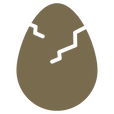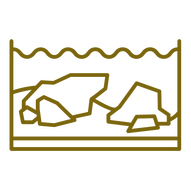Python regius - Ball Python
Ball Pythons are a docile, beginner snake that come in a very large variety of morphs. They are a tropical, terrestrial snake and are crepuscular, meaning they are most active at night. They get their name from their habit of curling up in a tight ball. They are also known as the Royal Python.
|
Bringing Your New Pet Home
When you bring your new snake home, you should already have a quarantine tank set up and ready to go. Place fresh water in a bowl in the tank, fresh substrate and offer food, but be aware it is completely normal for them to refuse food for the first couple days, or even longer. You should keep this new snake in a separate area from any other snakes you may have for 90 days, to ensure there is nothing it could spread to your other animals. Check for mites as they are very easily spread to other snakes. Monitor its eating and fecals as they may be strange for up to a couple weeks, but this is due to a new diet and environment. It is recommended you do not handle your new snake for the first 24-48 hours and keeping it to a minimum until it has started eating on its own. Always keep in mind that your new animal is in a new tank, with new decor/dishes/hides, and new faces watching them. They need time to become acclimated to it all. After this quarantine process, they can be safely introduced to their permanent enclosure if it's not already. Be sure to wash your hands before handling any other snake during this time. |
|
Enclosure
Depending on your need, there are a couple different ways to house a ball python. For the single snake owner, a PVC enclosure would be the most appealing. Glass terrariums can be used, but will not hold humidity well without modification. This can be achieved by covering most of the screen top with custom cut acrylic panels. Glass aquariums with screen lids can be used as well, but are not as ideal. Generally you want to have 10 gallons of enclosure for a baby or juvenile, and up to 40 gallons for an adult male. Adult females may need an even bigger enclosure. An additional way to house is a rack system with tubs, most commonly used by breeders to use their space most efficiently. Whatever type of enclosure you choose, be sure it is secure; snakes are escape artists and will use any opportunity to get out and explore. Screen tops with secure clips can be purchased for glass aquariums. Other enclosures should clip securely closed. |
|
Substrate
A variety of substrates can be used for ball pythons. Newspaper and paper towel are the easiest to clean and cheapest, but they don't offer as much visual appeal. Appropriate loose substrate options include shredded paper, aspen, coco husk and cypress mulch. The latter two offer the best humidity but need to be cleaned more often to prevent molding issues. You can also aid in humidity by misting your enclosure now and then to keep humidity levels up, or offering a hide box filled with damp substrate to aid in shedding. Spot clean weekly and completely replace all bedding every few months. |
|
Heating
Ball pythons are cold blooded, so they rely on their environment to regulate body temperature. It is important that the temperature be around 87-90° on one side of the tank, while the other side of the tank be in the upper 70s or lower 80s so the snake can thermoregulate by moving from one side of the tank to the other. The heat source should come from below the enclosure to aid in digestion and should take up approximately 1/3 of the bottom of the outside of the enclosure. Never put an under tank heater inside the enclosure or use a heat rock. For a glass or PVC enclosure an under tank heater is best, but for a rack system heat tape is most efficient. A thermostat should be used with any heat source.
|
|
Lighting
Ball pythons are crepuscular, meaning they are active at twilight. They should be exposed to 10-12 hours of light per day, but they do not need UVB lighting. Reptiles thrive under UVB lighting, so you may certainly offer it to your ball python for added health benefits. All lights should be on a timer to offer a natural day and night light cycle. |
|
Cage Decor
Since they are crepuscular, they need to have places to hide from the daylight to sleep. These hides can be as fancy as you prefer, from something store bought to an overturned plastic container with a door cut out. There should be at least 2 hides; one on the cool side which should be kept moist to aide in shedding, and another should be kept on the warm side. The moist hide can be kept damp with wet down paper towels or sphagnum moss. Low branches, rocks, cork pieces and fake plants can be added to the tank for visual appeal and for your snake to explore and use to aid in shedding! |
|
Humidity and Shedding
Ball pythons are a tropical species, so they require moderate humidity. Access to the moist hide mentioned in decor to help them aid in shedding will keep the humidity level at an appropriate level without additional efforts. Snakes will shed their skin as they grow. You’ll notice their color will appear dull when they are about to shed and their eyes will take on a blue tint. They cannot see well during this period of time, so may refuse food and strike in defense. A snake should shed in one complete piece - if they shed in pieces or have pieces stuck to them, your humidity needs to be adjusted. |
|
Feeding Ball pythons are carnivores and kill their prey by constricting it. Typically, their diet consists of mice, rats, gerbils or african soft fur rats. They prefer to hunt at night with the aid of heat pits on the upper jaw. Depending on the breeder and how they were raised, some may only take live prey. If this is the case, be sure to never leave your snake alone with the live prey as they can be severely injured. Frozen/thawed prey is the best choice for the average pet owner as it is readily available at most pet stores. Thaw the prey to room temperature by soaking in a bowl of lukewarm water, or leaving it out for a few hours to thaw. Never use a microwave to thaw food for a snake. Size of prey offered depends on the size of your snake. The size of the prey item should be approximately the width of the snake at the largest part of its body. As your snake grows, so should the size of the prey offered. Most snakes eat every 10-12 days. Babies and juveniles may need to eat more often. Ball pythons tend to be picky eaters, so don't be alarmed if your snake refuses a meal or two, but check that your temperatures, humidity and enclosure setup is proper. The best way to feed a snake is using a tongs to dangle the prey in front of them until they strike for it. Feeding at night will greatly improve the chances of a successful feed. |
|
Handling
Ball pythons are usually open to being handled and with regular contact, can become very tame. They rarely bite, instead they curl up into a tight ball when frightened. Hold your snake in your hands securely and let them explore. Don't force a frightened ball to uncoil. Never handle a snake that is about to shed unless necessary, as their eyesight is compromised and the chances of being bitten or struck at are higher. Do not handle your snake for 2-3 days after feeding to allow them to properly digest their meal. Handling too soon can cause regurgitation. If you are unsure about taking your snake out of the enclosure, snake hooks or tongs are handy for aiding in handling. Be sure to support the entire snake, using the hook to support the area closest to the head and your hands to support the rest of the body. |
|
Shopping List
|
|
www.goherping.com/ballpythons is an excellent source for further, in depth research on ball pythons!
|




























